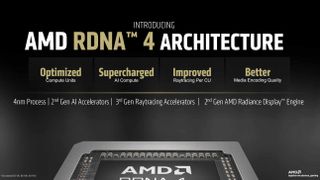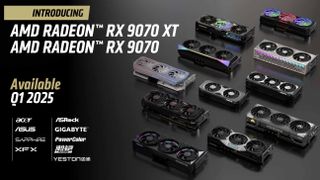AMD's David McAfee and Frank Azor have explained RDNA 4's absence from its CES press conference this year, and also spent a bit more time with us talking about its new "gamer-first" graphics card architecture. And that means making sure the cards are designed efficiently from both a performance-per-watt and manufacturing point of view.
"We've been working a lot in the architecture to drive efficiency," McAfee tells us backstage after the AMD keynote. "We know where gamers buy products; it's well below that $1,000 price point. And we are aiming for a card that delivers outstanding performance where most gamers are buying their cards today. And that's not $1,000 plus, that's well, well below that."
That's maybe a thinly veiled swipe at the expectedly expensive graphics cards rival Nvidia is thought to be announcing in its own CES keynote today. And that announcement is part of the reasoning behind RDNA 4 not getting its own announcement at the show, featuring only in a pre-briefing ahead of CES.
But this focus on efficiency is the number two priority for the RDNA 4 GPUs.
"So I would say number one priority is focusing on improving performance in the areas that gamers care about most," says McAfee. "And I think, I think in this generation, you'll see it as big ray racing improvements, big ML Ops improvements for things like FSR 4 and ML Super Resolution.
"I would say the second priority—that will be very clear when we show you more details about the product—is every part of the architecture is designed for efficiency. And efficiency is a really broad word. I'm not necessarily talking about performance per watt. I'm sure performance per watt is part of that, but it's also about making sure that the manufacturing process, the design decisions, like all of that, is incredibly cost optimized to deliver the best value to the end user."
These priorities are all about AMD's discrete graphics division trying to play to its strengths and build on the successes it had from the RX 7000-series of GPUs, and try and avoid its failures. Largely that's about creating more cards like the RX 7800 XT and RX 7900 GRE, in other words, cards in the volume, affordable segment of the market and not try can compete with Nvidia in the ultra-enthusiast arena.
This is a strategy AMD has used to some success in the past, and here it's specifically designed to try and improve on a dwindling share of the GPU market.
Frank Azor goes into some of AMD's thinking on this. "So the cliche thing is, 'oh, we listen to our customers.' I mean, that's what I don't want to come across and say, but we really did try to go to the drawing board on this and say, 'okay, how do we build a gamer-first, a customer-first type of card?'

"Because, you know, the opposite sometimes has been true. We've been doing what we think we need to do, and maybe we didn't listen as much to the market as we should have. And, you know, third time's charm... This is kind of the fourth time."
CES 2025

Catch up with CES 2025: We're on the ground in sunny Las Vegas covering all the latest announcements from some of the biggest names in tech, including Nvidia, AMD, Intel, Asus, Razer, MSI and more.
There are other things AMD is aiming to do with this generation, including making it easier to compare where its cards match up against the competition. This is the reasoning behind the new RX 9070 nomenclature, something requested by AMD's retail partners:
"Try to make it easier for them to be able to shop us versus the competition," says Azor, listing ways it's created the new RDNA 4 range. "Don't use ambiguity and confusion as a tool. Try to solve that, instead of using it and hoping that that's going to work in your favor. So we're really trying to listen to the feedback and apply it in this generation."
AMD is talking a good game so far, and if it can create a mass-market, affordable GPU that punches a little above its weight then it could have some meaningful impact on its market share. But it's still going to be a little while until we find out the full details.

 1 week ago
10
1 week ago
10









 English (US) ·
English (US) ·